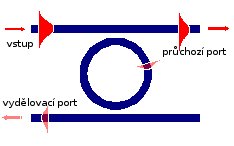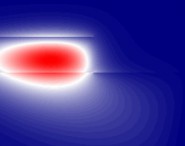3D vectorial modelling of photonic waveguide microresonators
Year: 2004
Prof. Jiří Čtyroký, DSc.; Ladislav Prkna, MSc.; Milan Hubálek, MSc.
Photonic waveguide microresonators are very promising building blocks for photonic large-scale integrated devices combining functions like spectral filtering, add/drop wavelength-division multiplexing (WDM), space switching, modulation, etc., with expected extensive applications in metropolitan and access photonic networks. The basic idea can be understood from the left figure below. Waveguide ring microresonators coupled by evanescent coupling (optical tunelling) to straight waveguides. The way where the optical signal goes depends on its wavelength: if the ring microresonator is off resonance, the signal is only weakly affected by the presence of a microresonator and exits from the “through” port, while at resonance it appears at the “drop” port. As the resonance wavelength of a microresonator can be changed electrooptically, thermooptically or using optical (Kerr-type) nonlinearity, such a device can be used not only as a passive spectral filter or add/drop WDM multiplexor but also as a tunable filter, as a modulator, or even as an optical logical element. In order to keep both the size and radiation loss of the microresonators small (typical diameter of the ring microresonator varies from a few micrometers to hundreds of micrometers), high-refractive index contrast waveguides have to be used. For the design of such structures, a 3D vectorial modelling of optical field distribution in the microresonators is necessary.
We have developed a novel semianalytic method for accurate and efficient calculation of vectorial electromagnetic field distribution in circular microresonators on a standard PC computer. The method is based on mode matching and is especially suitable for accurate calculation of radiation losses in both ring and disk microresonators. The right figure shows as an example the distribution of the dominant (vertical) electric field component of the fundamental TM eigenmode of the disk microresonator. The field discontinuity at horizontal interfaces and radiation into substrate in the right down direction are clearly visible.
The method has been developed within European project IST-2000-28018 „NAIS“, and in combination with the coupled-mode theory developed at the University of Twente in the Netherlands it forms an original and efficient tool for modelling and design photonic microresonator devices.
- J. Čtyroký, L. Prkna, and M. Hubálek, “Guided-Wave Optical Microresonators: Calculation of Eigenmodes,” Microresonators as building blocks for VLSI photonics: International School of Quantum Electronics, 39th Course, Erice, Italy, 2003, Proc. AIP, pp. 72-90, 2004.
- L. Prkna, J. Čtyroký, and M. Hubálek, “Ring Microresonator as a Photonic Structure with Complex Eigenfrequency,” Opt. Quantum Electron., vol. 36, pp. 259-269, 2004.
- L. Prkna, M. Hubálek, and J. Čtyroký, "Vectorial eigenmode solver for bent waveguides based on mode matching," IEEE Phot. Technol. Lett., vol. 16, pp. 2057-2059, 2004.
- L. Prkna, “Rotationally symmetric resonant devices in integrated optics,” PhD thesis, Charles University in Prague, 2004.
- L. Prkna, M. Hubálek, and J. Čtyroký, “Field Modelling of Circular Microresonators by Film Mode Matching,” IEEE J. Sel. Topics in Quantum Electron., vol. 11, No. 1, 2005, v tisku.



